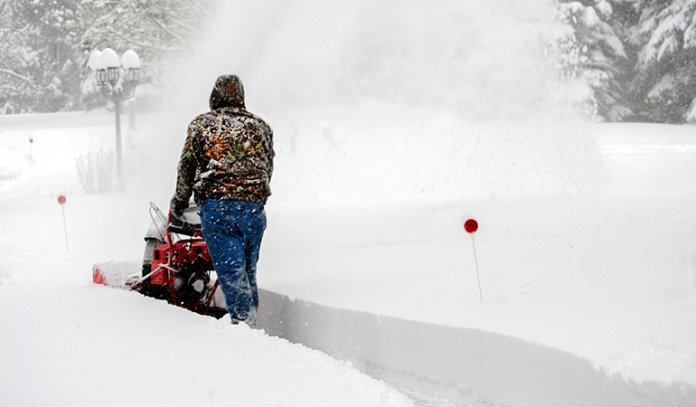A single stage snow blower uses an auger to gather and move snow, while a two stage snow blower has an additional impeller that helps to discharge the snow farther away. Two-stage snow blowers are generally more powerful and can handle deeper, heavier snow, while single-stage snow blowers are typically smaller and more maneuverable. A single stage snow blower is more suitable for small to medium driveways and sidewalks, whereas a two-stage snow blower is more suitable for large driveways and commercial use.
Contents
How to choose a Snow Blower?
When considering a used snow blower, there are several things to take into account:
-
Condition: Inspect the machine for any obvious signs of wear and tear, such as rust or damage to the auger or impeller.
-
Maintenance: Ask the seller about the machine’s maintenance history, including when it was last serviced, and whether or not all recommended maintenance has been performed.
-
Features: Consider the features that are important to you, such as electric start, self-propulsion, and adjustable chute direction.
-
Size: Make sure the machine is the right size for your needs, taking into account the width of the auger and the size of the area you need to clear.
-
Price: Compare the price of the used machine to the cost of a new one, and make sure you’re getting a good deal.
-
Brand reputation: Look for a reputable brand which is known for its durability and quality.
-
Warranty: Check if the machine is still under warranty and what are the terms and conditions for the same.
-
Test Run: If possible, ask the seller if you can test run the machine, to see if it starts easily and operates smoothly.
Which Snow Blower is best for you?
The best snow blower for you will depend on your specific needs and the conditions in your area. If you have a small to medium driveway, sidewalks, and walkways and experience light to moderate snowfall, a single-stage snow blower may be the best option for you. They are lightweight, easy to maneuver, and more affordable.
If you have a large driveway or commercial use and experience heavy snowfall, a dual-stage snow blower may be a better fit for you. They are more powerful and efficient at clearing heavy and deep snow, and have a wider clearing width. However, they are generally more expensive and heavy-duty which can make them more challenging to maneuver.
Ultimately, the best snow blower for you will depend on your specific needs and the conditions in your area. It’s important to consider factors such as the size of the area you need to clear, the amount of snowfall you typically receive, and your budget when choosing a snow blower.
Key Features of Single-Stage Snow Blowers
-
Auger: The auger is the main component that moves snow into the machine and directs it out of the chute. Single-stage augers are typically smaller and less powerful than those found on two-stage models.
-
Chute: The chute controls the direction of the snow as it is discharged from the machine. Most single-stage snow blowers have adjustable chutes that can be rotated to direct the snow where you want it.
-
Handlebars: Handlebars are used to steer the machine, and most single-stage models have comfortable and ergonomic handlebars.
-
Electric start: Some single-stage snow blowers have an electric start, which eliminates the need to pull a cord to start the engine.
-
Lightweight: Single-stage snow blowers are generally lightweight and easy to maneuver.
-
Compact: Single-stage snow blowers are typically more compact and easier to store than two-stage models.
-
Suitable for small areas: Single-stage snow blowers are best for small to medium driveways, sidewalks, and walkways.
-
Cost-effective: Single-stage snow blowers are generally less expensive than two-stage models.
-
Single Hand Operation: Single-stage snow blower can be operated with one hand which makes it easy to use.
Key Features of Dual-Stage Snow Blowers
-
Impeller: Dual-stage snow blowers have an impeller in addition to an auger, which helps to discharge the snow farther away.
-
Two-stage system: The two-stage system uses the auger to gather snow and the impeller to discharge it. This makes it more efficient at clearing heavy and deep snow.
-
Power: Dual-stage snow blowers are generally more powerful than single-stage models, making them suitable for larger areas and heavy snowfall.
-
Clearing width: Dual-stage snow blowers usually have a wider clearing width than single-stage models, allowing you to clear a larger area in less time.
-
Self-propulsion: Many dual-stage snow blowers come with a self-propulsion feature, which makes it easier to push the machine through heavy snow.
-
Adjustable chute: Dual-stage snow blowers often have adjustable chutes that can be rotated to direct the snow where you want it.
-
Electric start: Some dual-stage snow blowers have an electric start, which eliminates the need to pull a cord to start the engine.
-
Larger size: Dual-stage snow blowers are generally larger and more heavy-duty than single-stage models.
-
Suitable for large areas: Dual-stage snow blowers are best for large driveways, sidewalks and commercial use.
-
Dual Hand Operation: Dual-stage snow blowers require both hands to operate, which can make it more challenging to maneuver.
Frequently Asked Questions (FAQs)
It’s important to perform regular maintenance on your snow blower to ensure it runs smoothly and lasts for many years. This should include checking the oil level, cleaning the air filter, and replacing the spark plug. The manufacturer’s manual should have specific maintenance instructions and schedules. It’s also a good idea to have your snow blower serviced at the end of the season to prepare it for storage.
While snow blowers can be used on gravel, it is not recommended as it can cause damage to the auger or impeller. Additionally, using a snow blower on gravel can be dangerous as it may cause rocks and debris to fly out of the chute, potentially causing injury.
The type of oil that you should use in your snow blower will depend on the manufacturer’s recommendations. Some manufacturers recommend using a specific type of oil, such as a 4-cycle oil, while others recommend using a synthetic oil. Always refer to the manufacturer’s manual for specific oil recommendations.
Proper storage of your snow blower will help to ensure that it is in good working condition when you need it next. To store your snow blower, be sure to empty the fuel tank, change the oil and run the engine for a few minutes to circulate the oil and remove any remaining fuel. Clean the exterior and interior of the machine and lubricate moving parts. Finally, cover the machine or store it in a dry place to protect it from the elements.
Using a snow blower on a steep driveway can be dangerous and is not recommended. The steep angle of the driveway can cause the machine to lose traction and tip over. It is best to use a shovel or a snow plow for steep driveways.
The lifespan of a snow blower can vary depending on the make and model, usage, and maintenance. On average, a well-maintained snow blower should last for around 8-10 years. However, with regular maintenance and proper storage, some snow blowers can last for 15 years or more.
Conclusion
The main question of this blog is single stage snow blower vs two stage? In conclusion, a single-stage snow blower is best for small to medium driveways, sidewalks, and walkways with light to moderate snowfall. They are lightweight, easy to maneuver, and more affordable. A dual-stage snow blower is best for large driveways or commercial use and heavy snowfall. They are more powerful and efficient at clearing heavy and deep snow, and have a wider clearing width. It’s important to consider factors such as the size of the area you need to clear, the amount of snowfall you typically receive, and your budget when choosing a snow blower. Proper maintenance and storage are crucial to ensure the longevity of the machine. Always refer to the manufacturer’s manual for any specific recommendations and instructions.


